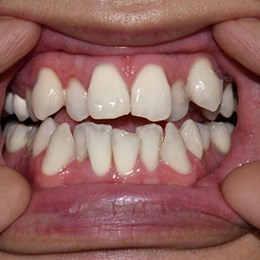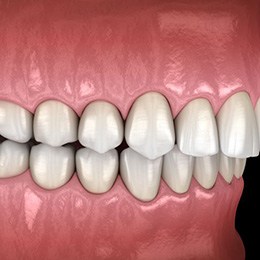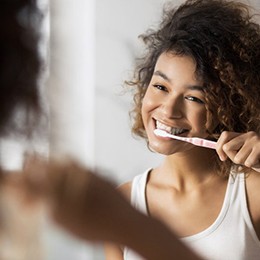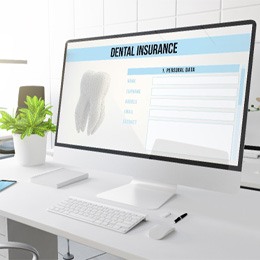Invisalign – Nepean, ON
Metal-Free Braces with a Clear Objective

Once you reach adulthood, the idea of wearing metal braces may not seem desirable. The good news is that you don’t have to! At Nepean Dental Centre, Dr. Bal can use Invisalign to address overcrowding, spacing issues, and bite problems. As a subtle and discreet method of orthodontic treatment, you can embrace a straighter smile without worrying about shiny, eye-catching metal. If you’re interested in learning whether Invisalign in Nepean is right for you, call us.
Why Choose Nepean Dental Centre for Invisalign?
- Personalized Treatment Plans for Each Patient
- Innovative Dental Technology for Accurate Results
- Dentist Who Cares About Patient Comfort
How Invisalign Works

Invisalign works by applying gentle, continuous pressure on teeth to shift them toward the desired positions. This is accomplished by creating customized trays from impressions taken of your smile. Once your aligners arrive in our dental office, you will be fitted with your first set, which you will wear 20-22 hours a day. Only taking them out to eat, drink, and keep them clean, you are to wear each set for 1-2 weeks before switching to the next ones in the series. With frequent dental visits to monitor your progress, you’ll notice a change in your smile until optimal results are achieved.
Who Can Invisalign Help?

As we mentioned above, Invisalign is not just discreet; it is also quite versatile! In fact, this treatment is suitable for many cases of mild to moderate dental misalignment. Might it be right for you? Our team can determine that during your consultation, after we have a chance to examine your teeth and get to know you a bit. In the meantime, here are a few examples of common orthodontic problems that these clear aligners can usually address:
Crowded Teeth

Overcrowding comes with its aesthetic drawbacks, but it can also negatively impact your oral health and your bite. For example, crowded teeth may trap food between them and be at an increased risk of decay. Fortunately, Invisalign can gently guide your teeth out of their crooked positions and into their properly aligned ones!
Gaps Between Teeth

If the gaps between your teeth bother you or are threatening your oral health, there is good news: Invisalign can fix spaced-out teeth as well! With these see-through, discreet aligners, we can gradually bring your teeth closer and closer together until the gaps are completely gone.
Overbite

A very small overbite is both normal and natural. However, when the top teeth rest too far in front of the bottom teeth, issues like speech difficulties and uneven dental wear can easily result. Invisalign, along with special accessories, is able to correct most cases of overbite, leading to improved oral function and aesthetics.
Underbite

An underbite is the opposite of an overbite; it occurs when the bottom teeth rest in front of the top teeth. Not only does this look unnatural, but it can also lead to problems with speech, chewing, biting, breathing, and more. Happily, though, Invisalign and its accessories are usually able to address underbites.
Crossbite

If only some of your bottom teeth rest in front of your top teeth, you have a condition known as a crossbite. This can interfere with your speech, your bite, and your facial aesthetics. Invisalign is often able to reposition the teeth in a way that removes a crossbite and promotes harmonious function between the upper and lower teeth.
Open Bite

If there is a vertical gap between your top and bottom front teeth even when your back teeth are touching, you have an open bite. This can make it difficult to pronounce certain words and increase wear and tear on your back teeth. Invisalign clear aligners are able to close open bites in many cases.
Benefits of Invisalign

Invisalign has become a popular choice for straightening smiles, offering several unique benefits over more traditional orthodontic options like braces. If you’re still debating on whether to begin your treatment, read more below. You’ll see why Invisalign receives so much praise and learn how they can fit seamlessly into your lifestyle. If you love what you learn, give us a call to schedule a consultation.
Better Dental Hygiene

With Invisalign, maintaining your oral hygiene routine is much easier than with traditional braces. The aligners are removable, allowing you to brush and floss your teeth without reaching for special tools. With Invisalign, interdental brushes and floss threaders are a thing of the past! All in all, choosing Invisalign reduces the risk of plaque buildup, tooth decay, and gum disease by decreasing the work it takes to maintain your smile.
The Aligners are Designed for Comfort

Invisalign aligners are made from smooth, comfortable plastic that won't irritate your gums or cheeks like traditional braces can. The custom-fit trays apply gentle, consistent pressure to gradually move your teeth into alignment, reducing the discomfort typically associated with orthodontic treatments. While there will still be some sensitivity when you first put them on or switch to a new set, this sensation is milder compared to traditional orthodontics.
Invisalign Is Nearly Undetectable

One of the most appealing aspects of Invisalign is its near-invisible design. The clear, transparent trays are hardly noticeable, allowing you to straighten your teeth without drawing unwanted attention. This makes Invisalign a great option for adults and teens who want to avoid “metal mouth” throughout their treatment.
The Treatment Is Life-Friendly

Invisalign offers a non-invasive approach to orthodontic treatment. With fewer overall appointments to come back to and lower requirements for maintenance, you may forget you’re doing it! Invisalign offers an ease of use that makes it an overall more comfortable and workable solution for straightening your smile. Many patients feel that simply being able to continue snapping perfect pictures with friends and family makes Invisalign worth the investment.
Invisalign Follow-Ups Are Fast

Invisalign treatment typically requires fewer dental visits compared to traditional braces. Follow-up appointments are usually short, occurring every six to eight weeks. These quick 15-to-30-minute check-ins ensure that your treatment is progressing as planned and allow our team to make any necessary adjustments.
You’ll Enjoy a Big Boost of Confidence

Since Invisalign is so discreet, you’ll never have to worry about feeling embarrassed to show off your smile. Even this simple act can help you project more confidence whether you’re out with friends or networking with coworkers. You’ll always look your best as you await the final results of your treatment, and that in itself can be a huge relief!
Understanding the Cost of Invisalign

Since there isn’t a flat fee for Invisalign, the best way to get an estimate of the price is by scheduling an appointment with Dr. Bal. Once he has an idea of how complex your case is, he’ll be able to provide you with an estimate of the price. Then, we can discuss all of the financial solutions we offer, including dental insurance, flexible financing, and special offers. That way, you can get the discreet orthodontic treatment you desire without breaking the bank!
Factors That Affect the Cost of Invisalign

At your consultation, Dr. Bal will conduct a thorough exam to determine:
- The complexity of your case
- If you need to straighten both arches of teeth
- If rubber bands or any other orthodontic accessories need to be added to your treatment plan
- How many aligners are needed
These are a few of the factors that will impact the upfront cost of Invisalign. However, you may need to invest more into your teeth-straightening treatment if you fall off-track with your original treatment plan. The good news is that you can help prevent that from happening by following all of the treatment guidelines, like wearing your aligners for 22 hours a day.
Invisalign vs. Smile Direct Club™: Which Costs More?

Simply put, mail-order aligner companies are often cheaper than Invisalign because they cut out crucial steps of the treatment process. For example, instead of taking detailed scans of a patient’s teeth and creating aligners from that, they rely on DIY impressions. Since there is a lot of room for error, you can see why many patients have experienced worsened misalignment and even dental emergencies, like teeth that have fallen out. These are just a few of the reasons the American Dental Association and other professional organizations have advised the public to opt for reliable, tested, and effective orthodontic treatments instead, like Invisalign.
Does Dental Insurance Cover Invisalign?

If they deem Invisalign “medically necessary,” then there is a good chance that they will cover a portion of the cost! Of course, dental plans vary from one patient to the next, which is why we always recommend familiarizing yourself with your benefits before making any assumptions. If you need any help understanding the fine print, don’t hesitate to ask us for help. We can answer any questions you have and handle all of the paperwork on your behalf so the entire process is as stress-free as possible.
Options for Making Invisalign Affordable

If you don’t have dental insurance at the moment, don’t worry – our team at Nepean Dental Centre also offers periodic special offers that can help make the cost of Invisalign more affordable. For example, new patients can start Invisalign with $0 down! Plus, we are happy to accept DentalCard Financing, which allows you to break down the cost into smaller, monthly chunks (sometimes with little-to-no interest attached too).
Invisalign FAQs
Does Invisalign Hurt?
When you first put on your trays, you’ll feel some soreness begin to set in. Since this is a sign that your teeth are starting to move, it’s actually a good thing! Plus, there are several easy ways you can alleviate any discomfort that arises, like sipping on cool water and taking OTC pain medication as directed. In short, some soreness from time to time is normal, but Invisalign is considerably more comfortable than traditional braces, and any discomfort that you do experience will be temporary.
What Are Invisalign Attachments?
Since “Invisalign” and “clear aligners” are used interchangeably, patients are often surprised when their treatment plan includes attachments. Essentially, these are bonded to the front-facing surface of your teeth so your trays have something to grip onto, helping them move more stubborn teeth. The good news is that they aren’t anywhere near as noticeable as metal brackets and wires, and, when they are on, you won’t feel them at all.
Note: If one of your attachments is a bit sharp, we can file it down a bit. You can also use dental wax as needed to protect your gums, lips, and tongue from irritation.
How Long Does Invisalign Take?
Although the average Invisalign treatment timeline is 12-18 months, it’s possible for your treatment plan to fall outside of that timeframe. For example, if you consistently misplace your aligners or don’t wear them for 20+ hours a day, then delays are probable. Conversely, if your case of malocclusion is relatively mild and you consistently follow all of the guidelines we give you, you could finish your teeth-straightening journey in just six months!
How Do I Clean My Invisalign Aligners?
Cleaning your aligners is not only easy, but it’s quick! First, get in the habit of rinsing your trays with clean, cool water each time you take them out. Second, use clean, cool water and a soft-bristled toothbrush to give them a more thorough clean each morning and evening. Some patients like using a mild dishwashing liquid as well, but don’t use just any household products; products like toothpaste and bleach are too harsh.
Can I Drink Coffee with Invisalign?
Yes, as long as you take your aligners out first! Remember, iced coffee can stain your trays and hot coffee can warp them. So, even if it’s inconvenient in the moment, you need to take them off beforehand.
Tip: Try enjoying this caffeinated beverage alongside your breakfast instead of separately! This will make meeting the 20-22 hour-a-day wear time easier, and it will help prevent dental discoloration since you’ll be brushing and flossing your teeth after each meal.
What Happens After Invisalign?
Your “final” appointment is when we will make sure you’re happy with the results, take “after” photos, and start the process of making your retainer! This orthodontic appliance plays a very important role in preventing orthodontic relapse, which is when your teeth begin to drift out of their aligned positions. To preserve your results and protect your investment, we will give you specific instructions on how often to wear your retainer as well as recommendations on the best way to maintain it.
